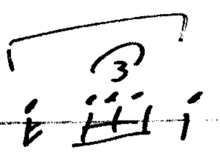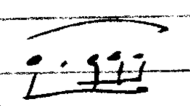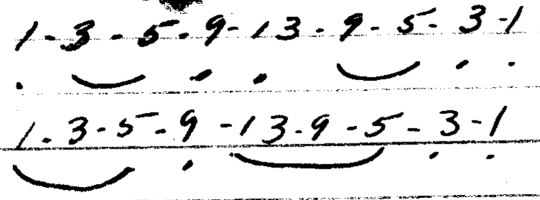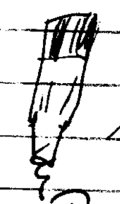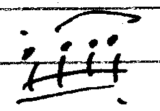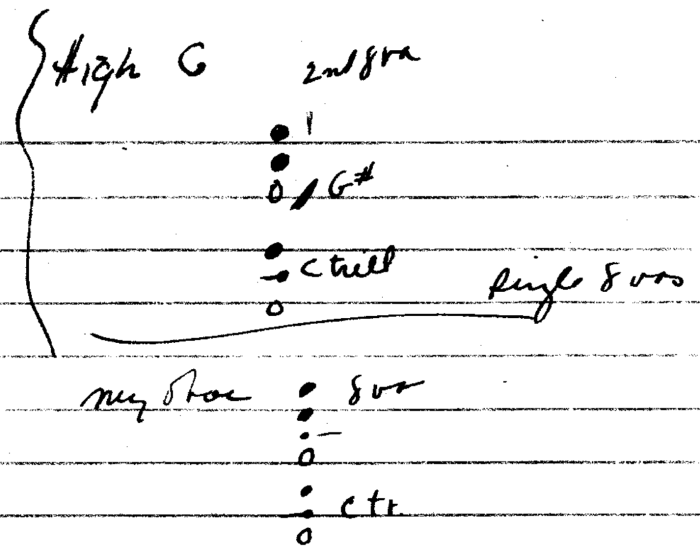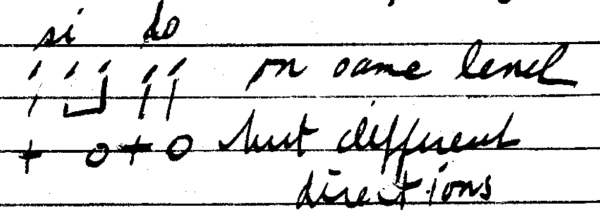Laila’s Lessons with Tabuteau 1944-45
Second Year at the Curtis Institute of Music
Lesson 1: October 7 , 1944
Measure 1: Play the Introduction more level.
Measure 9: No matter how pianissimo, a note must travel.
Measure 16: Practice 16th to quarter note: the 16th resolves on the quarter. Play on the last extremity of the circle. Punctuate the wind. Don’t blow as much. Don’t shriek on high D’s. Don’t push to the upper intervals: all weight must be in the lower note. Play on the tip of the reed for low notes at pianissimo.
Brod Etude 1: Transpose up to D♭. The whole point of the lesson is the interval of the 7th: it must be legato and smooth as possible. Practice the 10ths [measures 16-17]: Drive to the lower note which is the same as driving to an upper one. Don’t play the 10ths too loud, just touch them. Watch putting your little finger [of the right hand] curled under: on call is an institution.
Bizet Carmen [in the Vade Mecum]: Practice the solo.
Let the weight of the oboe rest on the thumbs. Push more forward with the embouchure and wind. Your embouchure should be like a whistle.
Lesson 2: October 19 , 1944
Brod Sonata 1, 1st Movement:
Measure 1: Note the contrast. Wait before each 16th.
Measure 9: Use opposition in pianissimo.
Measure 14: In octave leaps even if the marking is pianissimo, the intensity must be twice as much for the upper note.
Measures 34-35: Progression: ti-long-ta-ta-ti-long / 1-2 2-3 3-4. Note the distribution and scaling of the following:
Measures 36-37: Even if a note goes down in diminuendo, it must go higher and higher.
Measure 37: The ti is played on the length of the ta with no space between them:
Brod Etude 1: Play the character of the study: very tranquil, no restless motion, not too active. Intervals must be played on a level.
Brod Etude 2: Must be a little martial.
Lesson 3: October 23, 1944
Brod Etude 2: Transpose up to G♭. Punctuate! Play the first whole note ta on the length of the preceding half note. You must drive to lower notes as if going to upper ones. Play more on a level and don’t jut and stretch your neck.
Don’t stretch for intervals. Practice more drives on one note. Play from the diaphragm [stomach muscles]. Your playing must come from the floor.
Lesson 4: October 28, 1944
Regarding reeds:
Start the scrape [of the tip] from the sides [corners]. Leave more wood in the middle of the reed (comparable to the soundpost in a violin). Then balance the scrape from the back:
The reed should play in tune without any effort or pinching. You should not have to squeeze it. To get a darker tone, try to play flat and blow forward as if whistling. Practice the pitch of these notes for testing the reed: Low B-F♯-E 2nd register.
Pianissimo notes must play in tune. You must test the blowing of the reed. Quality of tone is always secondary to response and intonation. Practice broken 10ths as follows: down-up-down-up etc. (D-F♯-E-G. etc.). Make the reed with as little vibration as possible. Open up your embouchure for a full tone.
Lesson 5: November 6, 1944
Play 1-9-1 attacking on 1-5-9-5-1 and driving as follows:
In playing this exercise diatonically, you must make a circle and return. Bring it back to you on each change of note. Take care to attack on the up of the preceding note. You must travel and press between notes. Even though you are playing a softer note, you can have more speed. Play intervals and go slowly between the notes. Practice attacks.
Develop an understanding of the circle [arc of the phrase]: It is logic: rebound, up and down, gravity. The ascending ball gathers more speed until it reaches a certain turning point; it goes slowly and turns downward. It cannot come down without going up. The further up you go in a phrase, the better to come down.
Bizet Carmen, Smugglers March: 6 is the climax of the phrase; 5-4-3-2 is rebound:
Lesson 6: November 13, 1944
Practice the following:
Attack each: B♭-F-C-F-B♭ /1-5-9-5-1; then slur but attack the final 1. Play 1-5-9-5-1 with one note to the beat keeping the same range; then four notes to the beat, all those in-between notes attacked, then legato: B♭-C-D-E♭-F-G-A-B♭-C etc. as 1-2-3-4-5-6-7-8-9 etc.
Play the above scale, attacking but detaching each note, making the up and return on every note (not all are down impulses). You must phrase with the wind.
Use more lower lip turned in for a darker, not scratchy, tone
Ferling Etude 1:
Measure 1: Play between the notes.
Measure 3: Punctuate!
Measures 8 & 10: Play the grace notes on the beat.
Lesson 7: November 27, 1944
Ferling Etude 1: Drive between the notes; increase the intensity before high notes.
Brod Etude 3: Everything on the long.
Brod Etude 4: Increase the articulation.
Lesson 8: December 12, 1944: In the Ludlow Building Studio
Ferling Etude 3:
Measure 1-2: Play B long, then touch C on the length of the B.
Measure 3: B-B-A: down-up-long.
Measure 4: Finish on E: drive to it; lean on it.
Measures 6-7: D long going to C.
Measure 7: Drive the trill to E; play the E and the up of the trill; no accent on the E.
Measure 8: Press with the first finger of the left hand and pinch for the C diminuendo.
Measure 8-9: One line, like one long note; no jumps or breaks; maintain continuity.
Measure 10-11: Build the second staccato E to high D. Play the D on the intensity of the E and use the C key on the D so it won’t be sharp. Press with the left hand for a darker quality.
Measure 12: Group as follows:
Measure 14: Blow the low B full and free.
Measure 15: Play lightly on second note of the slurred pairs. Carefully play the sensitive notes, the seventh (G♯) and the third (C) in A minor. In major the sensitive notes are the tonic, subdominant and dominant.
Measure 16: Finish 4-3-2-1; play the third (C) lightly.
Measure 17: Play the appoggiatura on the beat, but place weight on the long note A.
Measure 18: Play even and smooth on this figure:
Measures 26-27: Play slowly between C and B; do not cut the C short like a guillotine.
Measures 29-30: Play A-B-C long, not broken off.
Measure 31: Drive the G♯ up to the A.
Measure 32: Take high A with the E key.
Ferling Etude 4: Practice slower. Take note of the skeleton form. Keep your left-hand thumb down: the thumb on the oboe is the equivalent of the thumb under the neck of a violin. You cannot play with it dangling loose. Ferling is as good as any music. Find the spirit of each study and take advantage of it.
Exercises:
Play on one note: 1-13-1, articulating on 1-3-5-9-13-9-5-3-1; then do it changing notes in the following rhythm:
Play with one note to the beat using the same pattern and with different articulations, all separated, all staccato. For example:
Lesson 9: December 30, 1944
Practice high notes pianissimo. Bite in on high A, B, and C. Each note takes a different embouchure. To maintain pitch, you must bite. On one note, you open up for the speed of the wind.
In a reed, the area in back of the tip must be twice the thickness of the back. Scrape the tip of the reed until it plays. Then scrape the back. There must be meat in the sides.
Don’t have too much vibration in the reed. Close a reed (not much) by pressing the blades together with your first finger and thumb before scraping on it. Make the tip as thin as possible.
Don’t blow directly into the reed. Increase the wind speed, but play pianissimo. Don’t play loud in the orchestra, just medium.
Lesson 10: January 8, 1945, at Curtis
Ferling Etude 4: Play with continuity of rhythm and on the positive side. Practice leaving off the finishing note.
Ferling Etude 3:
Measure 1: Don’t play all of the first six notes on one level. Progress.
Measure 4-5: Grazioso and full enough so you can play down to la.
Measure 6: Re is the highest note; sol must not be louder than the preceding do. Build to mi and keep the line.
Ferling Etude 5:
Measure 1: This study’s beginning is the same as the beginning of Etude 3. The groups are like bowing: you must come back up before you go down again. This is like the earth going around the sun, the heart beating, and inhaling and exhaling. If you stop breathing you would die; music must be the same.
Measure 4: Increase.
Measure 9: Finish on A: play it long and play the dot firmly. D is up, C♯ is down with inflection.
Measure 10: Same thing as in measure 9.
Measure 11: Not too active: do, si, la, sol, la Increase to the climax on…
Measure 13: re. Drive to do, likewise fa to mi; both are up-down. In this measure, la is long, as is re. Use a different wind on do to si.
Measure 16: Wait before the grace note, and leave space before it.
Measures 17-18: Firm: E is the finish. Then si-sol.
Measure 20: Sol is finish, but go on immediately: there are four groups of triplets. The final la♯-si must have an up inflection and tenderness.
Measure 21: Down on mi, travel to…
Measure 22: mi, and hold it full length.
Measures 23-24: Smooth intervals.
Measure 28: Build the G trill to C and play C fuller.
Measures 32-33: Si-la-sol-fa / up-up-up-down.
Measure 33: Wait before the grace-note inflection on fa in order to give room for the next three notes.
Measures 36-37: More on this group. Don’t rush the 32nds.
Measures 39-40. Drive the G trill to B; play the dot and lean on it. Heavy; collapse on your arm on the B. Then A, further up, higher, and on a different wind. G is down, likewise for its octave.
Good attack on la today! [tuning note for ensembles].
An informative way to practice: play scales and broken thirds all on 1.
Lesson 11: January 15, 1945
Ferling Etude 4: Play the spirit of this study. Wide intervals must be like a jackass!
Measure 7: More on the C.
Measure 8: Brilliant and hit B hard.
Measure 9: More on the second note than on the first.
Measure 10: Accent the right [low] notes. At the end of this measure, E is up and D is down.
Measure 12: Hit more on the upper notes of the intervals.
Measure 14: C is the climax of the whole phrase; don’t collapse.
Measure 19: Slow or broaden. For B-C-D going to high E: take time.
Measure 21: Not too heavy on the nish [of finish = A] but immediately heavy on the F.
Ferling Etude 5: transposed to A♭ major.
Measure 1: Lean more on the G.
Measure 4: Lean on the G and play the rest coming back down.
Measure 13: Up and break, then up-down. Don’t let the wind down on the up; drive it to sol.
Measure 17: Trill better: it is too active; play it smoothly. Practice the G to A♭ trill and increase as if on one note.
Measure 18: Play the impulse of the second beat after down on the G.
Measure 35-36: Play up before the pianissimo.
Measure 38: On the last three 32nd notes: up-up-up.
Measure 39: On the trill leading from G to B, break afterwards, but not the wind.
Measure 39-40: The impulse is up, down, break, down. Keep the line: don’t sock a note following a softer one.
Lesson 12: February 5, 1945
Ferling Etude 7:
Measure 1: You must turn the wind: up-up-down. Practice this pattern on one note.
Measure 3: The 32nd note must be higher than the preceding note.
Measure 5: Drive the end of the trill to the high note C, so the latter won’t sound forced.
Measure 8: Put the weight on the half note.
Measure 25: 1-2-3/ 3-4-5 on the triplets.
Ferling Etude 8: The staccato must be free. Increase the length; more on each note and longer:
Measure 4: The second 16th must follow immediately:
Measures 29-30: Practice the interval: high B to low E.
Brod Etude 5:
Measure 1-4: Play the first line in one breath.
Measure 3: Play the G on the up of the preceding note. Don’t play sharp.
Measures 52-53: Add a turn before the final octave. Play this every day.
For distribution: if you play 1-2-3-3-4-5-6 on pp, p, mp, mf, f and ff, you already have 30 levels, more than the notes on the oboe.
Lesson 13: February 26, 1945
Practice thirds: up-up-down, i.e. la-fa-mi , si-sol-fa etc. Up is done partly with the embouchure as well as with the wind. Practice intervals all on one even wind, not moving, just placing the notes on it.
Lesson 14: March 19, 1945, in Room 2B at Curtis
Brod Etude 7:
Measure 1: Don’t make the ups stronger than the note they resolve on. Play the first note firm, but short and supported from the diaphragm.
Measure 2: Make the high D vibrate (via speed of the wind). Feel this in your forehead. Press on the suspension.
Measure 3: G must be strong enough so that E♭ can be played lower.
Measure 15: Play the root with inflection and punctuate the end.
Play these studies in different rhythms. You must work and sing.
Brod Etude 8: C is a melodic line. Play each of these lines differently. Progress! Play the interval in-between, not the notes. Feel the tightening or squeezing. Use the embouchure to play the intervals. They must be smooth like a glissando.
Grace notes and appoggiaturas are only ornaments; make them short and put the life on the primary note.
Ferling Etude 10, Polacca: try to crystalize the form and find the spirit. Play very short staccato in the runs, like spiccato bowing.
Lesson 15: March 27, 1945
Play with the pressure of the wind. Press for high notes. Have a firm grip on the oboe: push in for legato. Exhale air before beginning the attack. Play without pinching the reed. Get ready to whistle. Whistle the exercises. Practice whistling and then have your lips do the same thing when playing. Change position on the reed.
Lesson 16: April 16, 1945
Brod Etude 10: Put weight on the tied note. Travel. Make more tone.
Lesson 17: April 18, 1945
Sellner Duo 1, 3rd Movement: Play the 16ths quickly.
Lesson 18: April 23, 1945
Ferling Etude 11:
Measure 1: The very beginning must be played on a down impulse.
Measure 6: The speed of the upper D must be twice as much as the lower one.
Measure 8: Scale the triplet, longer on each note and going up.
Measure 11: More on high B♭.
Measure 16: Press on high C; lean on the low E up. You must make a loop on the A before driving to the D higher. The D is to be played on the length of the fa. The ending leading to measure 17: 1-1-2 | 3 with more on 2.
Ferling Etude 12: Practice this slowly. The second 16th is important.
Lesson 19: April 25, 1945
More embouchure: more in and out. Smile tightly for high notes. Feel with your lower lip. Make it sound. Get the feel of the reed for the high notes. After you take them, then do something with them.
Whistle into the reed. Don’t pinch. Let it be free and sing. Increase the intensity. Play intervals, singing in-between the notes. Going up in numbers doesn’t mean louder. It can sound up, though.
Lesson 20: May 14, 1945
Practice arpeggios, in all articulations. Practice broken 3rds piano, then 10ths.
Hold the top note in a phrase like a painter’s stroke up and then come equally down with no break in-between.
Get the cadenza from the Deux Pièces pour le hautbois of Charles Lefebre and play it in all keys. Buy the Bach Sonatas for Violin and Cembalo and study them musically. Practice the Ferling Studies and Émile Paladihle’s Solo pour hautbois.
Practice piano, don’t blow. Play high notes softly with good quality and don’t force. Maintain one line. Play scales with all articulations.
Lesson 21: May 22, 1945
Don’t stretch your neck for high notes. Play all on 1: the dolce tone. Then add more tension in the embouchure in order to make high ones ring.
Bach Sonata 1, 2nd Movement: Don’t play the trills so roughly.
Beethoven Seventh Symphony, 2nd Movement: Play the second oboe passage on the same level, but in different directions:
Lesson 22: May 25, 1945
Practice on the reed alone. Increase the numbers etc. Hold the pitch of the reed at C for this is the strength required to play. There should be three pitches on the peep of the reed: B, C, and D corresponding to embouchure positions for the three octaves: D, D, D and half-way between B and C for the lower octave.
Works played today for Tabuteau:
Grieg: Norwegian Wedding March
Ravel: Le Tombeau de Couperin
Beethoven: Trio for Two Oboes and English Horn
Lefebre: Deux Pièces for Oboe and Piano
Paladihle: Solo for Oboe and Piano
Ferling: Study [12]
END OF THE SECOND YEAR AT CURTIS: 1944-45
Diploma Granted. Post graduate study at Curtis for the following semester year 1945-46 was arranged by Tabuteau.






